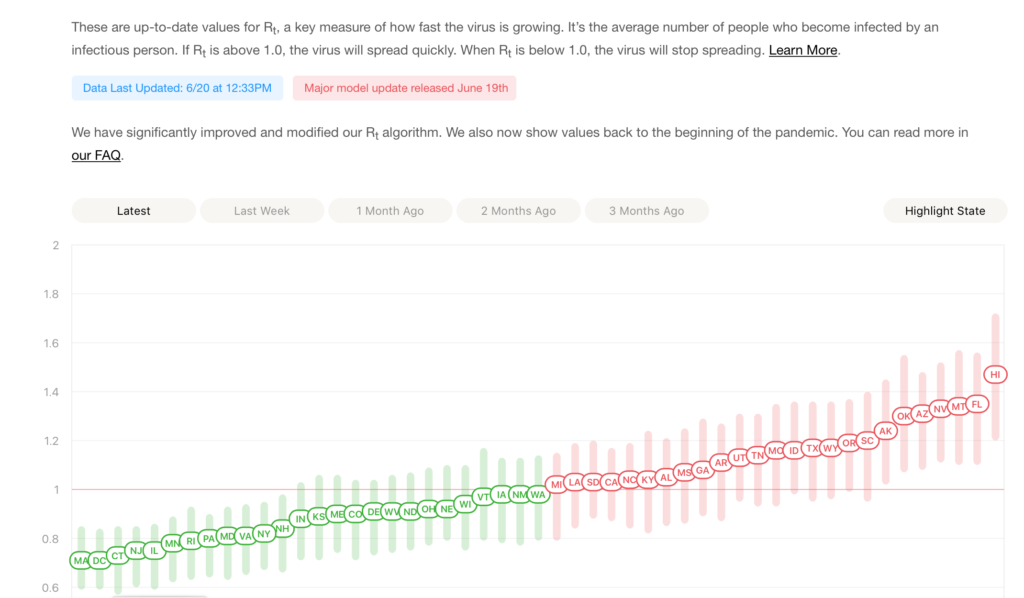May state employment: At what cost?
The Bureau of Labor Statistics released state-level employment data for May this morning. Looking over the last two months, where things stand since March, largest job losses are in Hawaii, Michigan, New York, and Nevada, all around 20%. There’s a big cluster of states that lost about 15% of their employment over the two months, including the Eastern states not listed above, and Kentucky. Clustered just above 10% are many large Western and Midwestern states, West Virginia, North Carolina, and New Mexico. Those down 10% and less include more of the Southern states, and the Plains and Mountain states. Smallest two-month declines were in Oklahoma and Utah, -6%, followed by Arkansas, Arizona, Idaho, Mississippi, and Nebraska, all -7%.
Our diffusions indexes, which were all 0 in April, except one case of construction hiring, rose to a broad 49 overall, with Leisure & Hospitality, 49, leading the way, followed by education and health, 47, trade/transport & construction, 46, and professional/business services 38. Government work was up in only 2 states, Wisconsin and New Mexico, and DC.
Looking at Leisure & Hospitality employment, only the District of Columbia and Hawaii added to April losses in May, now down 63% for the two months combined. In Oklahoma and Montana L&H work is down only 10% over the two months, and New York, -56%, Massachusetts, -52%, with Delaware & Michigan, 49%, close behind. The largest losses are heavily concentrated in the Northeast and Midwest, with L&H employment off between 40 and 63% in fifteen states. California, Oregon and Connecticut are at the bottom of that column, within striking distance of -40%.
Losses of, very roughly, 10%, in Oklahoma and Montana, to 35%, Maine, Ohio, Wisconsin, are concentrated in the Mid- and South-West, the mid-Atlantic, and the Southeast. Losses in the Plains states all round to about 20%, and in the Mountain West and across the Southwest generally to the high teens. In Utah, Idaho and Tennessee L&H losses total about -15%. None of this is surprising, and there does seem to be a relaxation between more lax state policies, for now. L&H work in Alaska is down 25%.
This is a noisy series with small samples. Largest declines in unemployment rates occurred in Mississippi & Kentucky, around -5.6 pps; in Indiana, Nevada & Arizona, around 5pps; in Vermont, Ohio, Alabama, and Tennessee, around -4pps. Unemployment rates rose in Minnesota, Connecticut & Florida, and lost less than 1 percentage point in Texas, Wyoming, New York, and Alaska.
We’d be more encouraged by all of this of 8 more states hadn’t crossed over the line into the “spreading quickly” red zone this morning in the tracker we sent around on Monday.





Microscopic atmospheric particles & Pioneer 10
Alexander Morse, researcher at Rockefeller Institute, reports CO₂ emissions will fall 5% this year. CO₂ has fallen by 20% in Wuhan, while microscopic atmospheric debris fell by 71% since March 24th in India.
Neither Morse, nor we, are suggesting this is the solution to our ecological problems, or that we focus on anything outside health and relief right now, but such a dramatic reduction is important knowledge.
(Pioneer 10’s images of Jupiter, from NASA, where everything is free.)
For the future, we could try carbon-cost programs. Some estimates of social costs per ton run to $400: The Obama administration estimated between $42 to $62 per ton; the Trump administration between $1 to $7 per ton.
So let’s turn to the states, where initiatives have generated about 50% of growth in renewables. And not a zero sum: Between 1970 and 2017 a witch’s brew of pollutants fell by 73%, while GDP grew by 270%.
If you can see the western sky this evening, look for red giant Alderbaran blazing to the left of Venus.
If all is well, Pioneer 10, launched in 1972 & last heard from across 7.6B miles in 2003, is still heading out. Weighing <600 pounds, carrying pictures of a man & a woman, the solar system, and how to find us relative to 14 pulsars, it should pass Aldebaran in 2 million years. We know how to do this stuff. Analysis here: https://rockinst.org/blog/coronavirus-has-improved-air-quality-what-does-that-mean-for-climate-policy/ Cool graphic: https://www.space.com/nasa-satellite-air-pollution-us-northeast-coronavirus.html